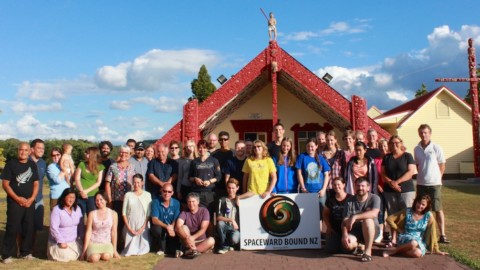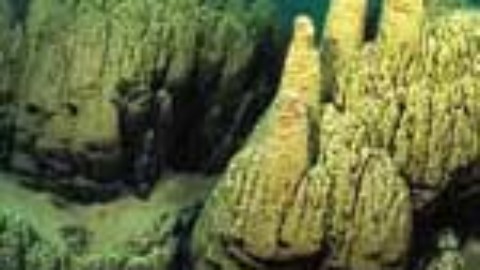The Icebreaker Life mission was proposed to search for life on Mars. While it was not chosen for the next Mars flight, it was wonderful for me to have the chance to look closely at some mind blowing human ingenuity.

SOLID being tested at Rio Tinto, Spain, one of the best terrestrial analogs of Mars
In 2014 I had the opportunity to work with the Icebreaker Life team, at NASA Ames. Icebreaker Life is a collaboration between NASA Ames, Lockheed Martin, Goddard Space Flight Center, Jet Propulsion Lab, MDA US Systems, Honeybee Robotics and CAB (Centro de Astrobiologia, Spain) and Malin Space Science Systems. The project consists of a rover, a drill and an instrument, the Signs of Life detector (SOLID) that will look for biomolecules deep inside the Martian soil.
Whilst at Ames, I looked at the planetary protection part of the project, which in this case deals with contamination from terrestrial organisms. In other words, how do we make sure that our instruments are sterile so that the scientific discovery on Mars is not in jeopardy from false positive readings, which could be generated by left overs from terrestrial microorganisms.
The irony of finding new life as it stands right now is that one must terminate all life to make absolutely sure that new life is detected… And it was my job to understand how exactly we do that. This falls in the realm of planetary protection.
Looking for life on Mars
The general agreement between scientists is that in ‘the search for past or present life on Mars, current and past missions have only scratched the surface’. According to Christopher McKay from NASA Ames, the driving goal for exploring Mars is finding signs of life’. And the general scientific opinion is that if life is to be found anywhere else other than Earth, this will be a major discovery. It might mean that life is common in the Universe.
The next generation of rovers will dig deeper and look harder.

NASA Ames scientist Brian Glass testing the Icebreaker drill in University Valley, Antarctic.
Talking about scratching the surface, the first missions sent to Mars to look for life (the Viking missions) started exactly with that. The idea was based on the hypothesis that microbial life would be widely present in the soils, as it is on Earth, and that it would respond to nutrients added to with liquid water. After successfully landing on Mars and testing its soils, the Vikings’ results were deemed inconclusive. After debates, an unknown oxidant was held responsible for the failure in life detection. Further missions (Phoenix lander) determined that the oxidant in question was Perchlorate. This is the most oxidized form of the element chlorine and not reactive at ambient conditions on Mars. Unfortunately, the Viking instruments heated the samples during their analysis during which the Perchlorates would have reacted and destroyed any organics present. Thus ironically the Vikings landers instruments destroyed the very thing that they were attempting to detect
Long term exposure to Perchlorates suppresses the Thyroid gland in humans but on Earth there are organisms feeding on Perchlorate (so not all is lost).
The issue with habitability
Some conditions must to be fulfilled for life as we know it to survive. High perchlorate content on the surface of Mars is generally not conducive to finding life there. Neither is the level of radiation. The current radiation at the surface of Mars is believed to be lethal for any terrestrial organisms.
Martian radiation, perchlorates, as well as observing the way life behaves in extreme environments on Earth, such as Antarctica or very salty deserts, convinced the scientists that if they are to look for life maybe the best bet would be to seek it beneath the surface of Mars.
Maybe life on Mars hides beneath the surface.
This is why the Icebreaker Life mission to Mars will drill down about 1 meter and analyse the ice shavings for biomolecules using SOLID. One meter of drill will sample through 6 million years of sediment at the suggested landing site.
Even finding simple organic molecules on Mars would make for a great discovery. Thus, another key goal of the Icebreaker Life mission is to test the hypothesis that the ice-rich ground in the polar regions might have significant concentrations of organics, due to protection by the ice from oxidants and radiation.
The mission is based on the same design as NASA’s Phoenix lander, and would land near the Phoenix site. Currently, NASA is evaluating proposals for future missions and Icebreaker Life is one of these proposed projects that aims to find life in the frozen ground regions of the Martian North Pole.
Only life can understand life
What intrigued me and also gave me much to ponder on regarding this project was SOLID, a key instrument of the mission, which uses Earth antibodies to detect possible life on Mars. A bold idea, SOLID is currently at version number 3.1, and has been tested in various analog Mars environments from Earth such as Rio Tinto, Antarctica, Atacama, the Arctic, the deep mines of South Africa and with samples from New Zealand’s geothermal areas sinters.
SOLID
SOLID (Signs of Life Detector) is an instrument designed and built by CAB in Spain to detect and identify microorganisms and biochemical compounds by analyzing liquid or solid samples (soil, ground rocks or ice). SOLID can analyze samples as small as half a gram of soil with sensitivities to parts per billion level. Once introduced in the instrument, a buffer solution is added to the samples and subjected to ultrasound that smashes up clumps and microbes into a slurry. Then, the filtered mixture is sent to a biochip with antibodies fixed to the surface. Any biological material in the sample, even traces of microorganisms similar to the antibodies used, would be captured by the antibodies. Another buffer solution is added with free floating antibodies tagged with a fluorescence molecule. These attach themselves to the captured biomolecules, thus the chip has captured biomolecules sandwiched between fixed and floating antibodies. A laser is used to excite the fluorescence molecule which is seen as a ‘light’ by a camera chip.
As only organic biomolecules carry biochemical information, if detected on Mars they will provide conclusive evidence of habitability and life on Mars as well as information on the biological nature of Martian organisms, even if the organisms themselves were no longer present. A hypothesis to be tested is that there has been an exchange of material and life between Earth and Mars due to meteoritic bombardment, and since the core molecular features in Earth life such as DNA, Lipids and ATP have not changed for millions of years, then the same features might exist in Mars life.
Some people argue that life on Earth might have originated from Mars as Mars cooled and became habitable before Earth. So just in case life’s chemistry on Mars is similar to the one from Earth, on each biochip are more than 450 antibodies to bacterial and archaeal strains, crude natural polymeric extracts, proteins, polysaccharides, nucleic acids, and small molecules such as amino acids, or polyaromatic hydrocarbons.
“Our hypothesis is based on the assumption that, under similar environmental conditions, organisms respond and adapt with similar strategies and molecular mechanisms. If we know and understand the terrestrial analogue environments to other planetary bodies, we characterize some of the life forms and the remains they leave in the medium, and develop systems for detecting them, then we could extrapolate this methodology for planetary exploration.” – says the SOLID team for CAB.
I hope that Icebreaker will make it to Mars and make grand discoveries.










